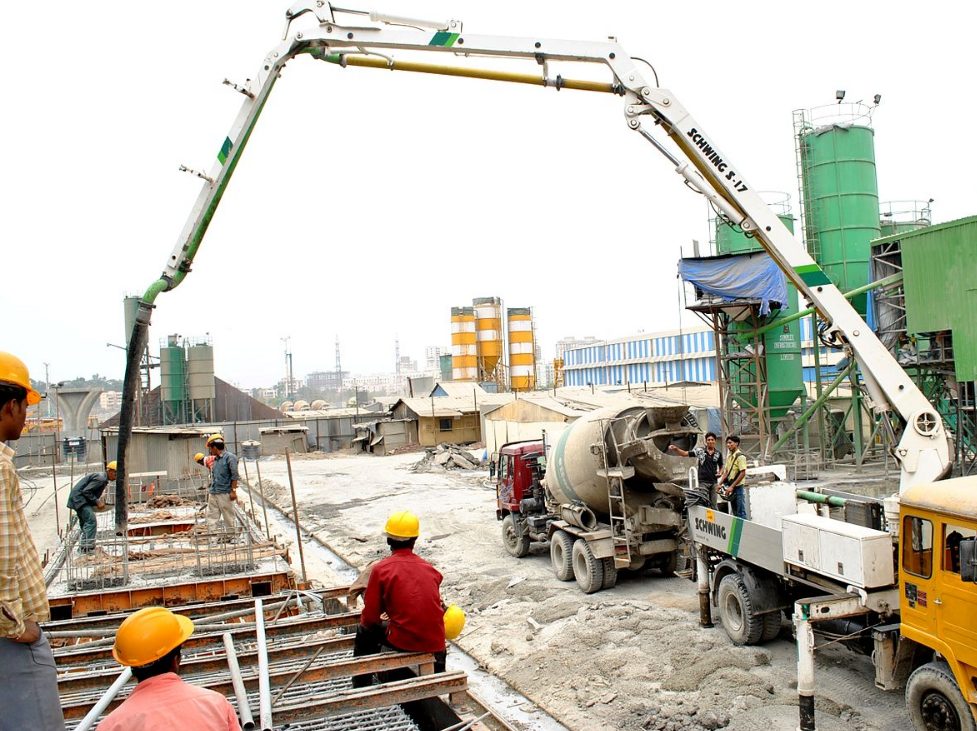Concrete pumps are the tools that allow you to transfer liquid concrete to the location of the casting. The basic principle of which was developed as a two-cylinder hydraulic pump with a principle of one-piston drawing of the concrete with the help of a hopper and the placement of the other hopper which is discharged and controlled with the help of a valve. Year by year, variations brought along many changes to make this procedure more mechanized through high pressure pumping at varying heights and lengths. This in turn gave high demand for faster construction for the high rise structures.
There are different types of concrete pumps available in the market based on their pumping pressure, ease of working and technologies namely,
1. Line Concrete Pumps
These are compact units that are mainly used for construction projects that are smaller in scale. The name derives from the formation of these pumps where they are kept in a linear arrangement attached to the back of a truck or a trailer. Therefore, it is also called a trailer-mounted concrete pump.
Playing a central role, these pumps are crucial for the effective conveyance of liquid concrete to the designated pouring location, thereby expediting the construction procedure with accuracy and rapidity. In guaranteeing the smooth and flawless operation of these pumps, elements like hydraulic hose fittings assume paramount significance. Serving as vital links bridging various sections of the hydraulic setup, these fittings enable the secure and dependable transfer of hydraulic fluid. This, in turn, upholds the safety and dependability of the hydraulic system, underscoring its critical role in sustaining the efficiency and integrity of the overall process.
2. Boom Concrete Pumps
Unlike Line Concrete Pumps, these stay in the same place the entire time of concrete pouring in a construction process. They are known as stationary pumps for this very reason. They have a larger dimension as compared to the line pump with a crane or a boom arm attached at different lengths.
If concrete pumping is required for different heights then this method can be used for efficiency. The formation of these pumps allows easy access above and below. If there are tight spots that need to be covered then these pumps can be helpful to overcome obstacles by such pumps.

While choosing the concrete pump you need to look at the manufacturer and their expertise. To know more, www.concretepumpingmelbourne.com. For this, you can also ask a local contractor for assistance to know the good ones. The quality of the concrete pump also needs to be analysed since they have to be in use for a long time., therefore need to withstand high pressure.
The purpose of the concrete pump along with the complexity of the project can also help in choosing the right concrete pump. You also need to look at the economic factors like estimation and budget.
The selection of the ideal concrete pump for your project can also be done through different types of construction works. If the construction is for huge roads or highway projects then a boom or a truck-mounted concrete pump is the ideal choice. When you need pouring at different altitudes the boom concrete pump is the best choice due to its ease of use. The best part of the boom concrete pump is that it can install two or three types of robotic pump lines to allow multi-purpose usage at the same time. The labour number due to this reduces thus, saving cost hugely.
If you wish to construct sidewalks or slabs then a liner concrete pump is the ideal choice. Wherever a smaller area of construction is available, the stationary pump is selected as the best choice.






